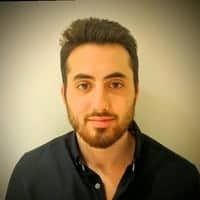Natural Hair Care Tips: How To Take Care Of Your Hair
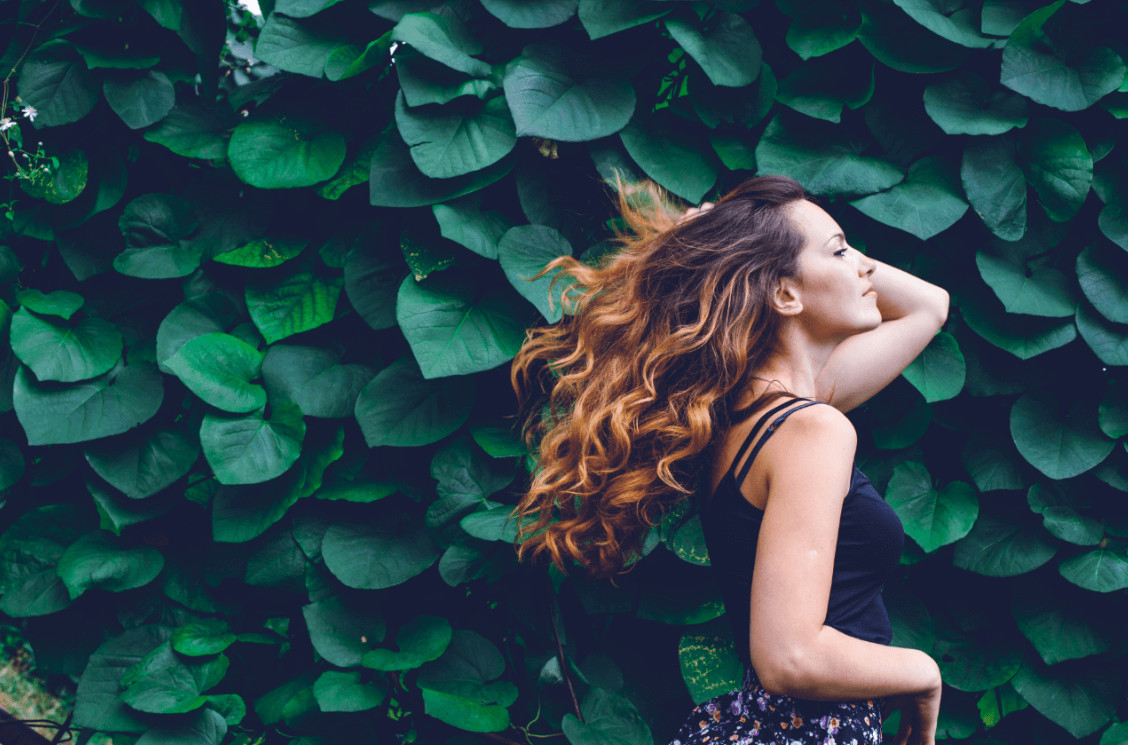
There is some confusion (or at the very least certain discrepancies) regarding the term “natural”, and this is especially true to the cosmetics industry. It seems that every company is now advertising itself and its products as being natural, but this isn’t always the case. The FDA itself has criteria in place for the term “organic” but not for the term “natural”, and this is true especially when it comes to cosmetics and hair care. Food is a different issue altogether, which has separate criteria and definitions.
The issue with calling cosmetics products natural is precisely that – anyone can do it. Where do you draw the line? What do you consider to be unnatural? If there is no regulatory body which is governing these claims, how does the consumer know?
Hair Care
Chemical Ingredients Vs Natural Ingredients Explained

Mixing chemicals.
There are chemical ingredients in every hair care product, which react and cause changes in matter. Not all chemicals are synthetic and harmful. Conversely, even the most natural and beneficial of chemicals can be harmful when misused.
As for the “danger of chemical ingredients” – it’s always been a question of balance and convenience. Hair care products come into contact with our scalp, roots, follicles, and strands, day in and day out. A certain percentage of these products invariably ends up in our bloodstream, and some of it sticks around for the long term. The real question is, what sort of chemical compounds do you want building up in your body?
Plainly put, the main reason to go natural is to get what you need, not what’s unnecessary. The current mainstream shampoo formulas get the job done, but at a price.
You use a shampoo to manage and maintain the scalp and roots. That’s what you want it to do, by definition. Studies and controversies are still ongoing, in regards to the effects of potentially harmful chemicals. The list of such chemicals is long, with the FDA monitoring things according to their standards.
Natural Hair Care Routine Breakdown
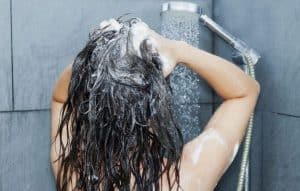
Woman washing her hair.
Natural hair care is like any other beauty routine: it takes work and dedication. Plus, there are bad natural routines, too. Just because something is natural doesn’t automatically make it good for your particular skin, scalp, and/or hair. In order for a natural hair care routine to work well, you must tailor it to your specific wants and needs.
Whatever the routine is, chances are you want to end up with clean, hydrated, and manageable hair which you can style. If your current routine isn’t providing you with these factors, consider changing something. Likewise, there are those with a daily routine, weekly or bi-weekly, monthly or bi-monthly, etc; some have a separate routine for AM and PM. Find out where you want to be on that spectrum.
What Is Sulfate Free Shampoo?
Sulfates are essentially what make the shampoo foamy and sudsy. They’re a common chemical in many cosmetics products because they allow oils to mix with other substances (dirt or grime), and then be washed away with water. Without sulfates, you may have a tougher job cleaning the surface of the scalp, but it could be worth it.
Sulfates have a bad rap, but it is not all justifiable. Some people should be washing their hair with a sulfate-free shampoo, while others will find there is no need to make the switch. The common sulfates – sodium lauryl sulfate, sodium laureth sulfate, and ammonium laureth sulfate – are considered controversial by some, but they remain a staple of mainstream commercial hair care products.
A sulfate-free shampoo will not lather up as much, and is often gentler and milder by definition. Sulfates can be harsh, yet efficient, chemicals. The FDA considers them safe, although this does not make them 100% compatible with all hair types. If you have frizzy, curly, or dyed hair, chances are you should go sulfate-free. Likewise, if you have damaged hair or relatively dry hair, you can use a sulfate-free shampoo without much noticeable difference.
Best Shampoo For Color Treated Hair

Woman with dyed hair.
Hair which has been colored is a unique case. Depending on the process, it could be that the hair has been through a lot. The last thing you want to do is add more chemicals and substances to the mix. Hair dye causes hair damage and it requires different kinds of attention. Incidentally, this is probably one of those times when you are going to want to avoid sulfates and harsh detergents.
For color-treated hair, you should find a shampoo which is good enough to clean your scalp and hair, but gentle enough to not strip your color away along with the oil and debris that it picks up. The ideal would be a shampoo designed for color-treated hair, though even then it is a question of what kind of treatment the hair has undergone. Bleached, dyed, highlights, low lights – there are differences, and the shampoo you use matters.
Some color-treated hair shampoos are all-inclusive, one-size-fits-all kinds of products. Others are separated according to a particular hair color or process. The classic examples of this are violet/purple shampoos for blondes or silver-haired individuals, and blue/purple shampoos for brunettes and darker hair. However, when it comes down to it, the best shampoo for color-treated hair will be the one which provides you with the results you are looking for.
Shiny Hair Explained
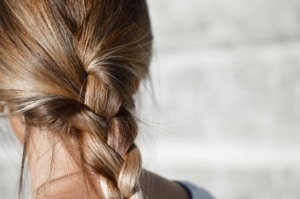
Girl with shiny hair.
What makes hair appear shiny is the angle of the hair cuticles. When the hair is able to absorb and retain moisture, it shines. When it is drier and more prone to damage, it often loses its shine. Although shiny hair is almost-immediately equated with healthy hair, this is not always the case. It’s all about the light hitting the cuticle, which is the outermost layer of the hair strand.
As such, you can technically have hair that is not very healthy but looks great and glossy on the outside due to some conditioner. When sebum, the body’s natural oil, or another form of moisture, is properly spread all over the hair strands, they will appear shinier. Getting shiny hair that is not greasy can be a difficult task. This is especially true for those with naturally oily hair, or those who over-wash.
Sealing the cuticle at the end of your hair care routine can be one way of retaining moisture. Protecting the hair from too much heat, overstyling, etc., can also contribute to the overall health and shine of your hair.
Hair Loss
Thinning Hair Explained
Male and female pattern baldness is the most common reason for hair thinning. Genetics has a lot to do with it, of course, although it’s not the be-all and end-all of the matter. Hair can thin with age, poor diet, incompatible products, and other factors. Hormonal changes and/or medical conditions and medication can also be fingered as culprits in this all-too-common issue.
Using a designated shampoo for thinning hair may be paramount. Without the proper products, you may find that your hair will keep thinning and/or shedding. Sometimes, these things are near-unavoidable, like with pregnancy or postpartum hormonal changes. But there are times when all you need to do is switch something in your routine or diet, and the body will be able to work things out in time.
Alopecia is the technical term for hair loss and hair thinning. It affects a large number of the population, although the differences between men and women are certainly there. With men, baldness occurs often. With women, it is more thinning on the crown of the head. But there are many different types of alopecia, and consulting with a doctor should be your first step.
Hair Growth Shampoo Breakdown

Woman with long hair.
Much like hair thinning and baldness, hair growth can be the result of the very same contributing factors: genes, diet, products, lifestyle. Hair thickening shampoos exist, but there are also mousses, creams, and even biotin-infused gummy bears that are purported to thicken and lengthen hair.
The shampoos which are said to thicken hair can give you an edge, but ultimately it is up to you and the products you use and consume outside the shower. A hair-thickening shampoo will be able to provide your scalp and roots with a veritable boost of nutrients, which can help the body do what it does naturally – grow hair. It can help the follicles and strands become more vital, and strengthen the hair in general.
By using such techniques, you can reduce damage and breakage, effectively causing more hairs to stay on the scalp, and thereby producing a thicker-looking head of hair. It’s usually not about growing new hair faster or longer, but about retaining the health and vitality of existing hairs.
Hair Loss Treatment Explained
With alopecia being such a commonplace condition, there are many types of treatments available, depending on the specific kind of alopecia. Early warning signs of hair loss include excessive flaking, bald spots, painful or itchy scalp, and a sudden onset of looser-than-usual hairs. Building up and revitalizing the hair from inside out can be done at any time, and the sooner you begin taking care of your scalp and roots, the better.
Some hair loss treatments are steroidal, others are non-steroidal. A designated hair loss shampoo can also be effective for some. A DHT blocking shampoo is also a very useful and common treatment, which has the potential to keep hair follicles alive and kicking. Different creams and salves are available over the counter, the most famous of which are Rogaine and Propecia. Those two contain minoxidil and finasteride, respectively, and have been approved by the FDA as a hair loss treatment.
Using shampoos that have additional proteins or essential oils, even if they are not designated as hair loss treatments, can also be used very effectively. That said, the genetic component is very dominant. It could be that you do everything “right”, and still end up with thinning or shedding hair.
Dry & Oily Hair Types
Dry Scalp Treatment Explained
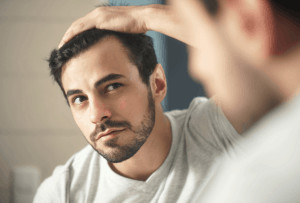
Man checking his hair in the mirror.
Having a dry scalp could be a standalone or secondary condition, and it could also be a warning sign before serious hair loss occurs. It can be chronic or acute. It can be painful and itchy, or nearly unnoticeable. This varies immensely from one person to the next, but it’s safe to say that most people do not want a dry scalp.
When your scalp (and hair) are dry, it usually means you are not getting enough moisture, or perhaps that you are not retaining the moisture you receive. This could be for a number of reasons, and the best way to diagnose this is through a healthcare practitioner- especially if it is a chronic condition. Using a shampoo for dry scalp can be the thing that makes the difference. When you use the right products, often the body can take care of itself naturally, without having to resort to anything drastic.
Keeping your scalp hydrated is the key. The body’s natural oil helps the scalp and hair stay healthy. Of course, you want to avoid going too much in the other direction as well. It’s about helping the body find and keep a balance. But again – diet, lifestyle, and genes all play a part.
Best Shampoo For Dry Hair
Dry hair is basically malnourished and breakage-prone hair. There are ways to combat the dryness, but the condition could be present due to any number of factors. Hard water, over-washing, under-washing, hormone imbalance, climate – these could all contribute to dryness of the hair strands.
The best shampoo for dry hair will be one which moisturizes the scalp and follicles, maintains the proper pH balance, and leaves the hair feeling and looking good. Essential oils can be of great use in these types of shampoos, as they are natural extracts that provide moisture and protection.
How To Get Rid Of Oily Hair

Girl with soft hair.
There are times when the body over-produces sebum, and in the scalp, this manifests as greasy hair and sometimes greasy dandruff flakes which the body sheds. A shampoo for oily hair can help to manage and control the moisture. It provides the hair with what it needs without overloading the scalp with substances that could build-up, nor causing extra sebum to be produced as a consequence.
Using a proper conditioner is also of great importance. A shampoo will cleanse and nourish, but using the wrong conditioner could then undo the situation and cause harm. Some use co-washing or the no-poo method as a solution, skipping the shampoo altogether at times. It is not recommended to condition every single day, but this should be ascertained on a case-by-case basis.
How To Get Rid Of Dandruff
Dandruff affects a large amount of the population, at one point or another. The flaking and scaling of dead skin cells is something that happens naturally, so the question is how much there is, and its origin. People with healthy scalps shed dead cells like everyone else, but those flakes are not noticeable, nor are they coupled with a red, painful, and/or itchy scalp.
Not all flaking is categorized as dandruff necessarily. What causes dandruff – that is, the visible condition we call dandruff – is when excessive shedding begins to take place. This can be going on for a number of reasons: dryness, fungus, climate, pH changes, use of certain products, a pre-existing skin condition, and also medication. A dandruff shampoo could be used to mitigate this condition, depending on its roots.
Dandruff often, though not always, coincides with the medical condition known as seborrheic dermatitis. Both of these conditions are treatable, as a general rule, because they both form primarily due to changes in the scalp’s population of fungi and/or its production of sebum. Anti-fungal shampoos and creams may be used, but washing the hair properly with the right shampoo is highly beneficial for the healing process.
Once you know what kind of dandruff you’re dealing with (dry dandruff or dermatitis), you can seek a proper solution. Get rid of your dandruff by keeping the scalp and hair relatively dry whenever possible, and by treating your scalp with the right kinds of products. It could be that your doctor will want you to use a prescription-only shampoo, but essential oils have also proven themselves in regards to dandruff.
Oil treatments are used to counter the excessive dryness and the scaling of the scalp. The key is finding a middle ground between being too dry and too moist. These oils can be in the form of a lotion, gel, cream, or shampoo. Some also use carrier oils and apply them topically as part of their hair care routine.
Clarifying Shampoo Explained

Woman with clean hair.
A clarifying shampoo’s job is to wipe the scalp clean of any build-up and residue which has not yielded to other, more gentle, forms of cleaning: substances like wax, styling gels, oil-based boosters, and the like. Over time, the scalp’s natural tendency is to acquire some build-up. This is normal, but so is getting rid of it every now and then. A clarifying shampoo does precisely that.
Some amount of build-up can actually be good for your hair, depending on the type of hair you possess. Furthermore, you don’t always want to strip your hair of literally everything, including the nourishing sebum. You should not use clarifying shampoo as a daily routine, but more like a bi-monthly treatment. It helps hair stay clean and not be weighed down.
Those with thin hair are usually the first to notice that their hair is being weighed down, and is altogether feeling unclean. With other types of hair, it could be some time before it’s noticeable. Whether as a preventive treatment or a corrective one, a clarifying shampoo is one of the best things in your hair care arsenal. Squeaky clean hair can be maintained much easier than dirty, heavy, product-laden hair, which is why this sort of shampoo can do a world of good.
Understanding Conditioner
Natural Hair Conditioner Explained
Hair conditioner is meant to help hair look healthy and be more manageable. While shampoo is essential for the sake of hygiene, conditioner can be considered essential for ongoing maintenance and appearance. A natural hair conditioner could be a commercial one which contains an abundance of natural ingredients, or it could be a DIY one that you make at home. Both of those options have their respective advantages and disadvantages, and both are viable.
Depending on the state of your hair and scalp, a natural hair conditioner will be able to provide you with necessary moisture and detangle your knots. It can also help to maintain the proper pH levels of the hair, and allow you to style it as you wish. Plus, it should be able to do all this without irritating the scalp, and without causing too much buildup which weighs down your locks. It might take some trial and error, but it is well worth it.
Commercial natural conditioners are aplenty, but the DIY route has a lot going for it. Unlike shampoo, which often requires harsh chemicals in order to scrub the scalp clean and unclog the pores, a conditioner is meant to enrich and nourish the strands. As such, it can often be made from more natural ingredients, and require less harshness to get the work done.
Olive oil, bananas, eggs, vinegar, coconut oil, apple cider vinegar, shea butter, honey, aloe vera, essential oils such as argan and lavender — these are all permissible, and you can use them to great effect in various combinations. Sometimes, all you really need after shampooing is a few natural ingredients mixed together to put the finishing touch on your hair, and that’s all. Choose wisely, depending on your hair type and your desired result.
What Is Leave In Conditioner?
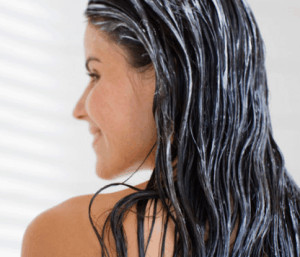
Woman with leave-in conditioner in her hair.
Some choose to make use of a leave-in conditioner, as opposed to an ordinary conditioner. These two are similar in many ways. What often separates them is the actual amount of conditioner by volume, which affects its consistency. In a regular product which is rinsed out after several minutes, there is a much higher amount of conditioner and it is thicker. But in a leave-in product, which is meant to stay on for hours or days at a time, there is a much lighter amount of conditioner in it. This allows the leave-in to continue doing its work without disrupting anything or overwhelming the hair in any way.
There is also the option of using an ordinary conditioner as a leave-in. However, this means knowing how much to apply, and also knowing how your hair reacts to that particular product or DIY concoction. Without any prior testing and knowledge, it is not recommended to use an ordinary conditioner as a leave-in. If you decide to convert a conditioner to a leave-in, use considerably less than you normally would.
As for when to rinse it out, there are different opinions. Some actually don’t rinse it out at all, but the rule of thumb with a leave-in is: rinse it out whenever you want.
Curly Hair
How To Take Care Of Curly Hair
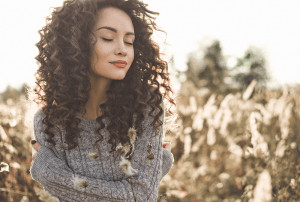
Woman with curly hair.
Curly hair is unique in the sense that it’s one of the more challenging hair types for sebum to contend with. If you have a straight strand of hair, the sebum can glide along it and nourish it. If you have a hair which is twisting, zigging, zagging, or coiling – that’s something of a problem. So, you may need to give your hair a hand, so to speak, in its natural maintenance. This is the basis of curly hair products.
It can be seriously frustrating to have curly hair sometimes, and managing it properly requires no small amount of dedication. Unlike straight-haired people, who have it significantly easier, it’s not as simple for curly-haired folk to just be lazy and let it go for a few days. When curly hair is not taken care of, the potential for entanglements – literal and figurative – rises appreciably and sometimes very quickly. I am not saying that curly hair is a liability, but it can be more difficult to maintain it.
Shampoo For Curly Hair
The best types of shampoo for curly hair are the ones that are sulfate-free. This does not apply across the board, but there is a better chance of sebum reaching the tips of your strands when there is nothing to wash them away. Sulfates are excellent detergents. The problem is that they also manage to clean the elements which are beneficial for the hair. With straight hair, this is less of a problem, but with curls, the sebum has trouble reaching the ends of the strands as it is, so it is best not to use shampoos containing sulfates.
Other things to look for in a shampoo for curly hair is a good amount of moisture. You want to make sure that your hair is getting clean, but you also want to know that it’s getting the nourishment it deserves. Dried-out curls are not the best feeling in the world.
Conditioner For Curly Hair
Same idea as with the shampoo: you want to avoid dryness, deliver moisture, smoothen the shafts, and, ideally, leave the hair smelling and feeling good overall. And like the shampoo, this is completely dependent on your style of curls and routine. So, there is no absolute right or wrong product (or ingredient). As long as you achieve the look and feel you’re going for, without weighing down your hair, you can consider the product a keeper.
Frizz and flyaways are a big problem for curly-haired folk, as are volume-related issues. If your curls fall flat after the shower, or are full of tangles, or are breaking more than usual – you might be using the wrong conditioner. There are commercial conditioners which are so mild, they could technically be used every time you shampoo. That said, conditioning every time you shampoo is usually not recommended.
Moisture is the key ingredient in any conditioner, and this is doubly true for curls. Don’t be afraid to experiment with DIY solutions that fit your curly cravings. Taking the time to find out what works for you could save you time and money in the future, and help your hair out a lot in the short and long term. Ingredients like shea, avocado, coconut, aloe, and other rich and fatty substances might just be what your hair’s been looking for.
Children’s Hair Care
Baby Shampoo

Baby after a bath.
Shampoos for babies are formulated in such a way, that they can clean the scalp and prevent buildup without the use of harsh detergents which could cause irritation. A natural baby shampoo will often contain very mild compounds and plant extracts. This is so as to not cause harm to the skin and/or eyes. Because baby scalps and hair are generally not as dirty, sweaty, or styled as adult scalps and hair, a gentle shampoo is all that is necessary to clean the baby’s head properly.
Some baby products are more natural than others, and using plant-based oils or extracts which are highly diluted can be a great advantage. A natural baby shampoo should not contain any dyes, artificial scents, or harsh detergents. Often with natural baby shampoos, the fewer ingredients on that list the better the shampoo could be. These products may not lather up exactly like their adult counterparts, but this is usually enough to get the baby’s scalp and hair cleaned in the best possible way.
As long as the baby’s hair and scalp are clean at the end of the bath, that’s all that matters. You can have a natural baby shampoo without adding various bells and whistles.
Kids Shampoo

Kids hair.
Like the aforementioned baby shampoo, kids shampoos are also formulated as a toned-down version of adult ones. Children’s hair tends to be denser but softer overall, and a child’s scalp is not the same as an adult scalp. The differences and changes become more apparent later on, during the onset of puberty. There is no special age where a child has to switch to an “adult shampoo”. That said, if there is any doubt consult with your pediatrician.
It is not always necessary to use a kid’s version of an ordinary shampoo, but it could make something of a difference depending on the child in question, and on their medical/physical state. It’s always an advantage to have the option of a kids version, which is less intense. Shampoos that contain essential oils and plant extracts should be formulated for kids, since those substances can be exceedingly potent. Some essential oils are not recommended for children. So, if you are going the DIY route keep that in mind.
Kids, much like adults, can hugely benefit from incorporating natural products into their hair care and hygiene. Some mainstream drugstore brands are useful and they get the job done, for sure. But if you want to give your child’s hair and scalp some extra love and care, natural shampoos can be the way to get that done.
Lice Treatment Explained
There are a couple of different lice treatments. Namely, ones which are for active treatment, and ones which are for preventive treatment. Often, a proper lice shampoo will act in two ways. First, it kills young and adult lice. Secondly, it also keeps the infestation from returning. Usually, a couple of washes are necessary with some days apart, in order to make sure that eggs and lice are both done with. It is recommended to follow through with a lice comb until the threat of infestation is quelled.
Different types of products are available – salves, creams, shampoos, pills. Some are prescription-only, and some are ordinary OTC products. In certain cases, where the lice are persistent and have possibly acquired immunity to the treatment, a doctor may prescribe an antiparasitic medicine. Regular OTC shampoos are usually not toxic to humans, and are made with natural ingredients which manage or prevent the infestation.
If you plan on using a DIY method, keep in mind that children (or are more at risk of contracting lice) ought to be treated with a more gentle formula. Essential oils are wonderful for treating lice and eggs. However, children are a lot more sensitive to these oils’ effects. Their DIY lice treatment must be formulated differently than an adult’s. Also, even with adults, essential oils can backfire and become a liability when they are misused.
Using too much or too little of a lice-killing treatment can be highly ineffective. Make sure to follow instructions whether it’s DIY, OTC, or prescription-only. Getting rid of lice is often repetitive since the life cycle of lice plays a part and requires extra treatment(s). If your OTC or DIY method does not solve the issue, as natural as it is, it might be time to consult with your physician or pediatrician.
Natural Ingredients For Healthy Hair
Keratin For Hair
Hair care products sometimes include keratin in them, which begs the question: what is keratin?
Keratin is what comprises a lot of our nails, hair, and skin. It is essentially groups of protein made up of amino acids. These are there to provide them with strength and robustness, but also elasticity. Keratin exists in many living creatures (humans, birds, reptiles, and more), and resides in different organs of the human body.
There are different types of keratin in the body. Consider your hair and your nails: both made from keratin, but are wholly different. The effect keratin has on the body’s cells differs according to the kind of keratin that’s being produced. One way to increase the amount of keratin in hair is by making use of a keratin shampoo or keratin treatment. These aim to reach the same end-goal: strong, smooth, shiny hair that is resilient and healthy.
Sources of keratin vary, as does their efficacy. There is keratin from animals and humans, and there is also synthesized plant-keratin available. Plants do not produce keratin naturally. However, they do produce similar strands of amino acids which can be manipulated to resemble the naturally-occurring kind.
Argan Oil For Hair
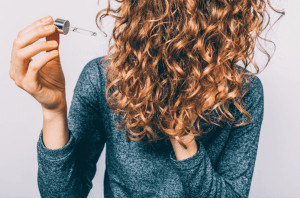
Argan oil for hair.
There are an abundance of hair and skin care products containing argan oil. It is undoubtedly one of the most celebrated and common essential oils around, especially in the cosmetics industry. So, what is argan oil?
The argan tree (Argania spinosa) and its nuts are native to parts of Algeria and Morocco. You can use the nut’s kernels as a source of food, wellness, and beauty, as they contain argan oil. There is great use for this oil in the hair care industry. If you’ve ever encountered Morrocan oil shampoo, you’ve basically met an argan oil shampoo + additional ingredients.
Argan oil benefits the hair in many ways. The oil contains a good amount of vitamin E and omega-3 fatty acids, and also has antioxidant and anti-inflammatory properties. It can protect the hair and make it more manageable. When you use it in measure it can seriously improve the quality of the hair and its vivaciousness.
Sage Oil Benefits For Hair
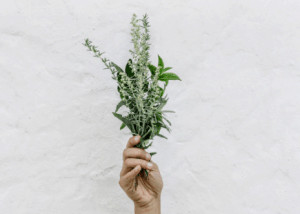
Sage oil for healthy hair.
Growing healthy hair can be an issue, especially with so many abounding elements which may disrupt the process. For example, hair products, styling apparatuses, weather, diet, and medical conditions, to name a few.
The oil of the sage plant (Salvia officinalis) is used in hair care products in order to moisturize and condition. It has a calming and soothing effect on irritated or inflamed areas of the scalp. This allows the body to maintain the proper production of sebum and manage the growth of healthy hair follicles. You can use sage oil as an ingredient in hair-loss treatments. It can also provide the hair with a healthy sheen.
Witch Hazel For Hair
At first, witch hazel may sound like something unattractive, like a character out of a Grimm Brothers book. What is witch hazel?
The tree known as witch hazel (Hamamelis virginiana) is native to North America and parts of Asia. Its extract is a highly beneficial substance that has been used for centuries. Its primary use was as an herbal medicine in the hands of the Native American tribes.
Witch hazel uses vary – from the treatment of a sore throat to combating acne and hemorrhoids. Using witch hazel for hair can be a good move. This is particularly true if you are facing hair loss, thinning, or a stubborn case of dry dandruff. Witch hazel benefits the scalp, and also the hair strands themselves as a result.
Conclusion
Natural hair care is not a big mystery, at least under normal circumstances. You may need to experiment and experience some trial and error with different products or DIY methods before you find a routine that fits you. But when you do find out what works best on you, your scalp, your skin, and your hair – you will be able to manage and maintain your locks with a lot less hassle and a lot more confidence. Your products will invariably be more tailored to your wants and needs, and you will be able to get clean and spiffy without saturating your head with unnecessary detergents, preservatives, fragrances, dyes, etc.
Whether you have oily hair or are more on the dry side; whether you have mild or severe dandruff; or whether you are curly, fine, kinky, or wavy – you will be able to find (or concoct) natural products which benefit you and your hair type. It feels great to take natural care of your hair, although many people are quite comfortable with supermarket-aisle brands.
Some people are more sensitive than others to build-up and irritation. This means that natural ingredients could be the go-to method for them. Not every product which says “natural” on it will indeed be natural, so understanding where your scalp and hair fit in is paramount. Also, remember that products that can harm you may still be 100% natural. Hair is an amazing thing, and it seriously classifies us as humans. Take good care of your hair, and it will thank you.
